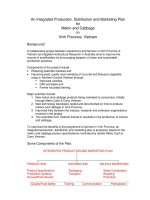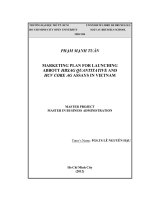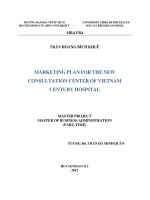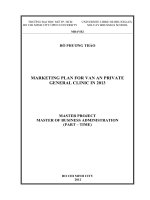Marketing plan for Van An private general clinic in 2013
Bạn đang xem bản rút gọn của tài liệu. Xem và tải ngay bản đầy đủ của tài liệu tại đây (1.62 MB, 93 trang )
TRNG I HC M TP. HCM UNIVERSITE LIBRE DE BRUXELLES
HO CHI MINH CITY OPEN UNIVERSITY SOLVAY BRUSSELS SCHOOL
MBAVB2
H PHNG THO
MARKETING PLAN FOR VAN AN PRIVATE
GENERAL CLINIC IN 2013
MASTER PROJECT
MASTER OF BUSINESS ADMINISTRATION
(PART – TIME)
HO CHI MINH CITY
2012
ACKNOWLEDGEMENT
I would like to express my deep gratitude to the following persons:
My supervisor, Professor Hoang Thi Phuong Thao, for her value time, her clear
guidance, and patience. She has kept me carrying out my final project and doing
till the end. Without her helps, I could not have finished my final project on time.
The Van an staffs who helped me in collecting information for my market
survey.
Mr. Tran Luat, Van An General manager, my mentor in this project. He helps me
to understand the operation, working processes of the Van An clinic
I would like to send many thanks to all professors of Solvay Business school, our
program coordinator, my classmates for useful knowledge and happy time during
the MBA course.
I would link to thank to my colleagues, my boss for supporting me the time to do
this project
Finally, I want to show my grateful to my family who always encourage and
support me to complete this project.
November, 2012
HOÀ PHÖÔNG THAÛO
DECLARATION
I hereby declare that this study project is my own original work and this is my
first marketing plan for the private healthcare sector which has not been
submitted to any university for any degree. All sources and helps that I used in
this topic have been reported and acknowledged in my study project.
November, 2012
HOÀ PHÖÔNG THAÛO
TUTOR’S COMMENT
The final project Marketing plan for the Van An private healthcare clinic in 2013 –
2014 conducted by student Ho Phuong Thao meets the requirements of MBA
program in terms of content, format as well as research survey.
During the time of doing this project, the student showed her hard working attitude
and seriously followed the tutor’s guidance
For the said above reasons, I introduce student Ho Phuong Thao to the jury to
defend her project.
70
CONTENT
CHAPTER 1: INTRODUCTION 1
1.1. Back ground of research 1
1.2. Research problems, and research objective: 2
1.3. Scope of the study 2
1.4. Research metholodogy 2
1.5. Structure of the study 3
CHAPTER 2: LITERATURE REVIEW 5
2.1. Strategic plan and Marketing plan 5
2.2. The marketing mix – The 7Ps 12
CHAPTER 3:
THE OVERVIEW OF THE HEALTHCARE SERVICES
MARKET IN LONG AN PROVINCE AND THE VAN AN MEDICAL
CLINIC 24
3.1. The Van An medical centre 24
3.2. The internal activites analysis 24
3.3. The external activities 24
3.4. The SWOT analysis 38
CHAPTER 4: THE MARKET SURVEY – CUSTOMER ANALYSIS 41
4.1. Target customer 41
4.2. Customer demographic 41
4.3. Brand name recognization 43
4.4. Customer’s habit 43
4.5. Customer assessment on Van An clinic 45
4.6. Customer satisfaction 54
CHAPTER 5:
PROPOSE THE MARKETING PLAN 58
5.1. Marketing objectives 58
5.2. The marketing plan 58
CHAPTER 6: CONCLUSION
69
LIST OF FIGURES
Figure 2.1: The 7Ps 13
Figure 2.2: the Porter’s Five forces 20
Figure 3.1: Long An map 26
Figure 3.2: The structure of Van An clinic 33
Figure 3.3: The Van An revenue in 2010, 2011, 2012 34
Figure 3.4: The Porter’s Five Force that effect on Van An private medical clinic
35
Figure 4.1: the ratio of Male and Female 42
Figure 4.2: Information sources to recognize the Van An clinic 43
Figure 4.3: Customer’s assessments on the time for documentary procedure at
Van An clinic 45
Figure 4.4: Customer’s assessments on the time for the check up process 46
Figure4.5: Attitude of doctor 47
Figure 4.6: Customer’s appraisement on staff’s enthusiasm and politeness 49
Figure 4.7: Customer’s appraisement on staff’s solution for their requirements49
Figure 4.8: Customer budget for a healthcare examination 51
Figure 4.9: Van An price and the customer’s acceptance 53
Figure 4.10: The price in comparison with the quality 53
Figure 4.11: Customers assess on Van An service 54
Figure 4.12: Customer assessments after using Van An service 55
Figure 4.13: Customer loyalty 56
LIST OF TABLES
Table 3.1: Statistic of Long An Healthcare system 27
Table 4.1: The ages range of Van An current customers 42
Table 4.2: Time to go for check-up 43
Table 4.3: Customer’s choices for personal check up demand 44
Table 4.4: Summary the customers opinions about the time 46
Table 4.5: Van An space and facility 50
Table 5.1:
The revenue of from August 2011 to August 2012 and the marketing
budget in 2013 64
Table 5.2: Trade promotion gifts and time line 64
Table 5.3: Cost of the trade promotion plan 65
Table 5.4: Expense and time line for each type 66
Table 5.5: total cost for marketing plan in 2013 68
APPENDIX
Appendix 1: The market survey form
Appendix 2: The results of the market survey
ABSTRACT
In recent years, the private healthcare sector develops and expands promptly.
Private medical clinics are established more and more each day. Inspire of
receiving the one way offers for so long, patients becomes customers, they have
more choices and they are treated more fairly. Both patients and private medical
units are happy because one has more options, one has its business going on well
and public hospitals are not affected, they are still overloaded.
As usual, private medical centers will satisfy their customer demands by doing
their best and doing what they think the best to their customers.
The purpose of this research is to define customer expectations, to understand
more about the object served by medical service supplier named Van An by a
market survey. The survey was conducted by both quantitative and qualitative
methods. Quantitative research is to find out the customer concerns, design the
questionnaire for the main part. Qualitative research was conducted by issuing
questionnaire forms to customers who go to Van An clinic have their health
checked up to get their responses. From 200 results collected, we analyze and
the results show that all factors as professional skill, attitude, working processes,
price, material facility all affect to customers choice and the power of customers
in advertising a service. Using the analyzed information, propose a suitable
marketing plan for Van An Clinic business to obtain its future targets.
1
CHAPTER 1
INTRODUCTION
1.1. Back ground of research
It is the legitimate aspirations of everyone to take good care of their health. People
need to know exactly about their health conditions, how to protect themselves from
implicit factors, how to deal with their diseases… The medical system in Vietnam
embraces public sector: state’s hospitals, local medical stations, public medical
centre and private medical sector: private clinics, private hospitals.
While the Public health care sector is waiting for breakthrough policies to solve its
problems on overloaded condition in public hospitals, human resource distribution
at local level hospitals, to control the quality of healthcare centers and control the
professional ability of medical officers… The demand on medical services still
imperative, increase rapidly and needs to be solved effectively. Along with the
demand of a huge amount of patients, a significant number of private medical
clinics and hospitals are born. From Minister of Health‘s data, there are 65,000
private medical clinics and private hospitals are established till end of 2011.
Like any others in private medical system, the Van An clinic was established as a
response to the patients demands. In some aspects, this kind of business also help to
share the burden of the public healthcare sector which is overload severely for
years, and satisfy its customers’ demands. Patients don’t waste too much time,
patients give money to get what they need with pleasures…
In this research, we are working on the business situation of the Van An general
clinic in 2007 – 2011 to find out the advantages, disadvantages, strong and weak
points that this company face off as well as the competitive abilities with other units
in Long An province, along with the research on customer behaviors in the medical
service area. Base on the result and the company strategy in 2012 – 2015, building a
suitable marketing plan to achieve the company goals.
2
1.2. Research questions and objectives
Unlike other fields, the healthcare sector operates like a one way structure and
suppliers do not have any tools or policies to inspire their customers due to the
heavily overloaded situation at almost public healthcare centers. Huge demands
with limited suppliers and customers are acquainted to accept what are offered
without any further requirements. In the private healthcare sector, customer is one
of the key factors that decide the existence of an organization. Therefore, this
survey is made to help a private medical clinic like Van An medical clinic to have a
fully recognition on customer demand and have suitable solutions to develop its
business.
1.2.1 Research questions
This research is following some questions as:
Q1: Why do patient go to the private clinic?
Q2: How can a private medical clinic exist in this fiercely environment?
Q3: What do patients expect from private medical center?
1.2.2 Research objectives:
- To measure the patients demand on the private medical sector
- To analyze and assess the business activities of Van An Clinic in Long An
province
- To orient the marketing strategy for the Van An Clinic in 2013.
1.3. Scope and limitation of the study
This study is about elements that related to the marketing activities in a private
medical clinic – Van An clinic – in Long An province.
1.4. Research methodology
This study was carried out by collecting data from the issued questionnaire and
using the secondary data of Van An clinic.
a. Qualitative research
3
Interview the 3 managers of the Van An clinic to know what they had
offered to customers, why they did it, what they will do to develop their
business in the future.
In-depth interview 10 random patients to explore their inquiries when using a
private general clinic for their healthcare demands, take notes, collect and
analysis these data, design the questionnaire for the next step.
b. Quantitative research
was conducted by issuing 250 copies of questionnaire
to customers of Van An. The interviewees are selected by convenience.
Interviewers are Van An staffs. Interviewees are people who come to Van
An for medical service purposes. Interviewers read the questionnaire for
interviewees to hear and answer, interviewers wrote down all answers from
interviewees in the questionnaire. The survey was implemented in 04 days
and at the afternoon of each day. 250 copies of questionnaire were offered,
200 useful results were collected, the rate of response is about 80%.
We use SPSS software for statistics. The statistics consist of frequency
statistic, mean …. We believe that this is a scientific process and the result
can be used as a basic ground for analysis and propositions.
c. Secondary data
Use the yearly revenue report of Van An in 2010 and 2011 with the
acceptance from the Accountant Dept and Operation Manager.
1.5. Structure of the study
Chapter 1: Introduction. This chapter provides the research background, research
objectives, research methodology, and structure of the study.
Chapter 2: Literature review. This chapter includes concepts, theoretical
framework and guideline for this study
Chapter 3: The Van An medical clinic overview and its market segmentation. The
general information of Van An medical clinic, formation and development of Van
An clinic, current position and current marketing activities.
4
Chapter 4: Data analysis. This chapter is about the patient attitude base on the data
collected from issued questionnaires.
Chapter 5: Proposed marketing plan in 2013 for Van An clinic.
Base on the data analysis from chapter 4, propose the marketing plan for Van An
clinic and the implementation of it
Chapter 6: Conclusion. This chapter provides the conclusion from the findings
from the research.
5
CHAPTER 2
LITERATURE REVIEW
2.1 Strategic plan and Marketing plan
Planning
is essentially a process directed toward making today’s decisions with
tomorrow in mind and means of preparing for future decisions so that they may
be made rapidly, economically and with as little disruption to the business as
possible
The role of planning
Planning leads to a better position, or standing for the organization
Planning helps the organization progress in ways that its management considers
most suitable
Planning helps every manager think, decide, and act more effectively and
progress in a desired direction.
Planning helps keep the organization flexible.
Planning stimulates a cooperative, enthusiastic approach to organization
problems
Planning indicates to managers how to evaluate and check up on progress toward
planned objectives
Planning leads to socially and economically useful results
Strategy
is the pattern of major objectives, purposes, or goals and essential
policies and plans for achieving those goals, stated in such a way as to define
what business the company is in or is to be in and the kind of company it is or it
to be.
Strategy specifies the direction.
6
Any organization needs strategy when:
• Resources are finite
• There is uncertainty about competitive strengths and behaviors
• Commitment of resources is irreversible
• Decisions must be co-ordinate between far-flung places and over time
• There is uncertainty about control of initiative
An explicit statement of strategy is the key to success in a changing business
environment. Strategy provides a unified sense of direction to which all members
of organization can relate. Where there is no clear concept of strategy, decisions
rest on either subjective or intuitive assessment and are made without regard to
other decisions. Such decision become increasingly unreliable as the pace of
change accelerates or decelerates rapidly. Without a strategy, an organization is
like a ship without a rudder going around the circle.
Strategic plan
is specifies the sequence and timing of step that will alter
competitive relationship
The objective of a strategic plan is to set the direction of a business and create its
shape so that the products and services it provides meet the overall business
objective
The strategy and the strategic plan are quite different things. The strategy may
be brilliant in content and logic but the sequence and timing of the plan
inadequate. The plan may be the laudable implementation of a worthless
strategy. Put together, the strategic plan concerns the relationship of an
organization to its environment.
The strategic planning process in Healthcare sector
7
May variation of strategic planning model have emerged in both business and
healthcare sectors, but the basic model has remained relatively unchanged since
its inception. In common way, it can be synthesizes into 4 stages as:
The first stage is the environmental assessment that focuses on the question of
where we are now, it includes 4 activities:
• organizational review, include mission, philosophy and culture
• external assessment of the market structure and dynamics
• internal assessment of distinctive characteristics
• evaluation of competitive position, including advantages and
disadvantages
The goals of environmental assessment is to determine which factors are subject
to the organization’s control and how external forces will affect to the
organization
The second stage is organizational direction. The main activities of this stage is
to develop a future strategic profile of the organization by examining alternative
future, mission, vision, value and key strategy
The third stage is strategy formulation. This stage establishes goals and
objective for the organization
Stage 2 and 3 address the question where should we be going? And the purpose
of these two stages is to determine what broad, future direction is possible and
desirable and what, generally, the organization is going to target as its future
scope of services and position.
The fourth stage is action planning, determining how we get there. This stage
involves identifying the actions needed to implement the plan. Key activities
include setting schedules, determine priorities, and allocating resources to ensure
the implementation.
8
Why strategic planning is needed in healthcare sector?
With the chaos pervading the healthcare field, many executives and not-for-
profit board may wonder if it is possible to plan effectively or to plan at all given
the uncertainty ahead. Why not rely on ad hoc planning based on educated
guesses and intuition? Healthcare organizations may have historically survived
using less formalized approached to make policy decisions, but today, providers
must be more thoughtful about their choices. Mistakes will result not only in lost
revenue but also closure. Fog (1994) suggests the following benefits of strategic
planning:
• Secures the future for the organization and the individual by crafting a
viable future business
• Provides a road map, direction and focus for the organization’s future –
where it wants to go and the routes to get there.
• Set priorities for the really important strategic tasks that absolutely must
be accomplish, including those hairy, burning issues such as lack of
direction and growth, lack of profitability and organization
ineffectiveness, that everybody talks and knows about this while
wondering why they are not being addressed.
• Allocates resources available for growth and change to the programs and
activities with the highest potential payoff
• Establishes measures of success so that the progress of the organization
and individual can be measured. It is a fundamental business and human
need to know where you stand
• Set inputs and ideas from all parts of the organization on what can be done
to ensure future success and eliminate barriers to that success in
9
accordance with the old adage that ten or one hundred or one thousand
heads are better than one.
• Gain commitment to implement to plan by involving the organization in its
development.
• Coordinates the actions of diverse and separated parts of the organization
into unified programs to accomplish objectives.
Marketing:
We can distinguish between a social and a managerial definition for marketing.
According to a social definition, marketing is a societal process by which
individuals and groups obtain what they need and want through creating,
offering, and exchanging products and services of value freely with others. As a
managerial definition, marketing has been described as “the art of selling
products”. But Peter Drucker, a leading management theorist, says that “the aim
of marketing is to make selling superfluous. The aim of marketing is to know and
understand the customer so well that the product or service fits him and sells
itself. Ideally, marketing should result in a customer who is ready to buy.”7
The American Marketing Association offers this managerial definition:
Marketing (management)
is the process of planning and executing the
conception, pricing, promotion, and distribution of ideas, goods, and services to
create exchanges that satisfy individual and organizational goals.
Coping with exchange processes—part of this definition—calls for a
considerable amount of work and skill. We see marketing management as the art
and science of applying core marketing concepts to choose target markets and
get, keep, and grow customers through creating, delivering, and communicating
superior customer value.
10
Marketing planning
is simply a logical sequence and a series of activities
leading to the setting of marketing objective and the formulation of plans for
achieving them. It is a management process.
The marketing planning process:
(Kotler, 2002)
Executive summary and table of contents: this brief summary outlines the
plan’s main goals and recommendations. It is followed by a table of content. It
helps top manager to find the plan’s central point quickly and a table of contents
should follow the executive summary.
Current marketing analysis: this section presents relevant background on sales,
costs, profits, the market, competitors, distribution and the macro environment,
drawn from a fact book maintained by the product manager.
The first major section of the plan describes the target market and the company
position in it. In the market description, the planner provides information about
the market, product performance, competition and distribution.
Markets are group of people or organizations with general needs to be meet so it
must define the major market segments. Therefore market relate directly to the
demand for products and services. It may be made up of different customer
segments. And customer segment is a group of customers which have the exhibit
similar needs and wants. When choosing a market target, those items should be
scanned as: size and growth of segments, competitive advantage, coherence with
mission and strategy of the company
After that, the planner reviews the product plan or brand. It shows sales, prices
and gross margins of the principal products in the product line. In section of
competition, this section identifies big competitors and their individual strategies
for product quality, pricing, distribution and promotion. It is also show the market
shares held by company and each competitor. Last section is distribution. This
11
section describes recent sales trends and developments in the primary
distribution channels.
Opportunities and issue analysis: this section identifies the major opportunities
and threats, strengths and weaknesses, and issues facing the product line or
brand.
Objectives: this section spells out the financial and marketing objectives to be
achieved.
Having studied the product’s threats and opportunities, the manager can set
objectives and consider issues that will effective them. It defines the company’s
objectives in the areas of sales, market share and profits, and the issues that
affect these objectives. And the objectives should be sated as goals the company
would like to attain during the plan’s term.
Marketing strategy: this section explains the broad marketing strategy that will
be implemented to accomplish the plan’s objectives
in this section of marketing plan, manage presents the broad marketing approach
that will be used to achieve the plan’s objectives. First marketing strategy is the
marketing logic by which the business unit hopes to achieve its marketing
objective. Second it consists of specific strategies for target markets, positioning,
market mix. It should details the market segment which the product or brand will
focus. And the manager should also outline specific strategies for such marketing
mix elements as new products, field sales, advertising, sale promotion, price and
distribution.
Action programs: this section outlines the broad marketing programs for
achieving the business objectives. Each marketing strategy element must be
elaborated to answer these questions what will be done? When will it be done?
Who will do it? How much will it cost?
12
Projected profit and loss statement: action plans allow the product manager to
build a supporting budget with forecast sales volume (unit and average price),
costs (production, physical distribution and marketing), and projected profit.
Once approved, the budget is the basis for developing plans and schedules for
material procurement, production scheduling, recruitment and marketing
operations.
Control: this last section outlines the control for monitoring the plans. Typically,
the goals and budget are spelled for each month or quarter so senior manager
can review the results each period. Sometimes, contingency plans for handling
specific adverse developments are included.
2.2 The marketing mix – The 7Ps:
Traditionally, the marketing mix has included four broad categories of variables
known as the 4P’s: Product, Price, Place, Promotion (McCarthy 1960).
Booms and Bitner (1981) proposed and expanded marketing mix for service
consisting of the four traditional elements (Product, Price, Place, Promotion) and
three new ones : Physical evidence (the physical surroundings and tangible
cues), Participants (all human actors in the service encounter including firm
personnel and other customers) and Process (procedures, mechanisms, and flow
of activities).
13
Product Price Place Promotion Participants Physical evidence Process
Quality Level Location Advertising Personnel Environment: Policies
Brand name Discounts and Accessibility Personal selling Training Furnishings Procedures
Service line Allowances Distribution Sales promotion Discretion Colour Mechandization
Warranty Payment terms Channel Publicity Commitment Layout Employee
Capabilities Customer’s own Distribution Personnel Incentives Noise level Discretion
Facilitating Perceived Coverage Physical Appearance Facilitating Customer
Goods Value Environment Interpersonal Goods Involvement
Tangible clues Quality/ price Facilitating Behaviour Tangible clues Customer
Price Interaction Goods Attitudes Direction
Personnel Differentiation Tangible clues Other customers: Flow of
Physical Process of Behaviour Activities
Environment Service Degree of
Process of Delivery Involvement,
Service Customer/
Delivery Customer
Figure 2.1: The 7Ps - Adapted from: Booms and Bitner (1981)
14
Pr
oduct
As the product is the item being sold to the customer, the thing that will bring in
money, its features and design need careful consideration. Whether the firm is
manufacturing the product or purchasing the product for resale, they need to
determine what product features will appeal to their target market. A
successful
company will find out what customers need or want and then develop the right
product with the right
level
of quality to meet
those needs now and in the future.
When an organization is considering introducing a product into a market, they
should ask themselves the following questions:
1. Who is the product aimed at
2. What benefit will customers expect from it
3. What will be its advantage over competitor products? Or its unique
selling point?
4. How does the firm plan to position the product within the market?
The answers to these questions will help a firm design, package and add value to
its products.
The perfect product must provide value for the customer. This value is in the eye
of the beholder —
we
must
give our customers what they want, not what we
think they want.
Price
A product is only worth what customers are prepared to pay for it. The price also
needs to be
competitive,
but this does not
necessarily
mean the cheapest; the small
business
may be able
to
compete with
larger rivals
by adding extra
services
or
details that will offer
customers better value for money. Your pricing must also
provide a profit. It
is
the
only
element
of the marketing mix that
generates
revenue
— everything else
represents
a cost.
15
Thinking
of price as ‘cost’ to the customer helps to
underscore
why it is so important
Price
Price positions you in the marketplace — the more you charge, the more value or
quality your customers will expect for their money.
Existing
customers are
generally
less
sensitive
about price than new customers —
a good reason for looking after them well.
If you decide in favor of a higher priced
added-value
approach,
remember
that
price ‘positions’
you
in
the
marketplace.
This means it gives an
indication
to
potential and
existing
customers of where to place you in relation to your
competitors.
Expectations
will generally be higher; customers will assume a
higher quality product or
service.
Everything about your
dealings
with customers
must
live
up to the
expectations
of this
positioning. Anything
that can be seen by
the customer must be consistent with these higher quality
expectations
—
packaging,
environment,
promotional materials,
letterheads, invoices,
etc.
Place
The place where customers buy a product, and the means of distributing your
product to that place, must be
appropriate
and
convenient
for the customer. The
product must be
available
in the right place, at the right time and in the right quantity,
while
keeping
storage,
inventory
and
distribution
costs to an acceptable level.
Customer
surveys
have shown that
delivery performance
is one of the most
important criteria when choosing a supplier.
Place also mean ways
of
displaying
your product to
customer
groups. This could be
in a shop window, but it could also be via the internet
The ideal place will be:
•
Convenient for the customer and the business
•
Accessible for the customer if it is the place where the product is sold
16
•
Low cost or free for the customer if it is the place where the product is sold
•
Reasonable cost to the business
Promotion
Promotion is the way a company communicates what it does and what it can
offer customers. It includes
activities
such as branding,
advertising,
PR,
corporate identity,
sales
management,
special offers and
exhibitions.
Promotion
must gain attention, be
appealing,
tell a consistent message and above all else
give the customer a reason
to
choose your product rather than someone else’s.
Good promotion is not one-way communication — it paves the way for a
dialogue with customers
Promotion should communicate the benefits that a customer obtains from a
product, and not just the
features
of that pr
oduct
Whether
your promotional material
is a single sheet or a complex brochure, folder
or catalogue, it must grab the attention of your customers. It should be easy
to
read
and enable the customer
to
identify
why they should buy your pr
oduct
A brochure isn’t
necessarily
the best way of promoting your
business,
the problem
being that once a brochure has been printed, the
information
is fixed. You
can’
t
change or remove anything should the need
arise.
A more cost
ef
fective
and
flexible
option might be a folder with a
professionally
designed sheet inside, over a
series
of your own information sheets produced in-house. These sheets can be
customized by
varying
them to suit the target customers and/or changing them as
required
Promotion does not just mean communicating to your customers. It is just as
important to
ensure
your
internal stakeholders
are aware of the value and attributes
of your products. This means communicating effectively to your staff/fellow
employees
so that they can be
knowledgeable
and share
expertise
with their









